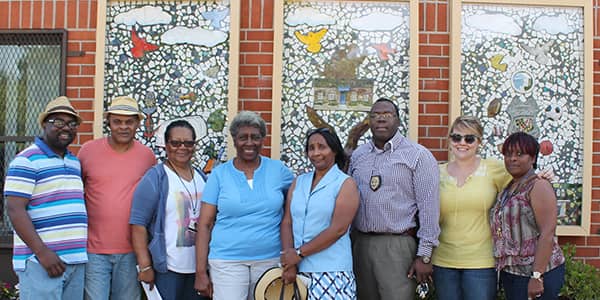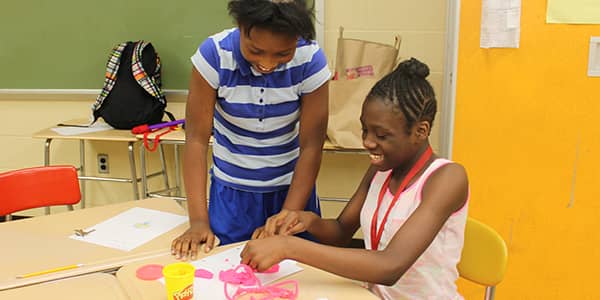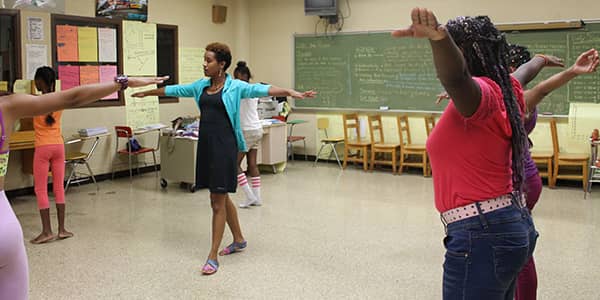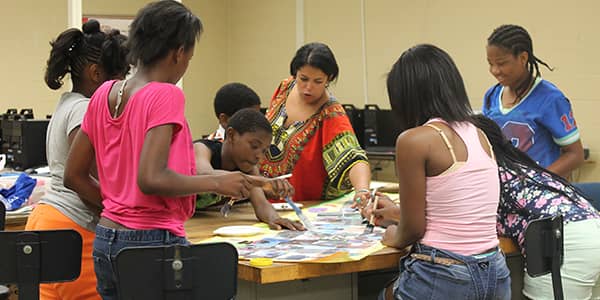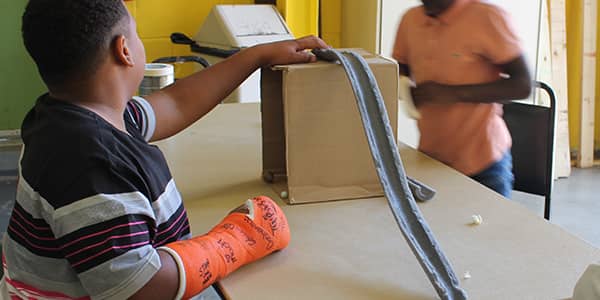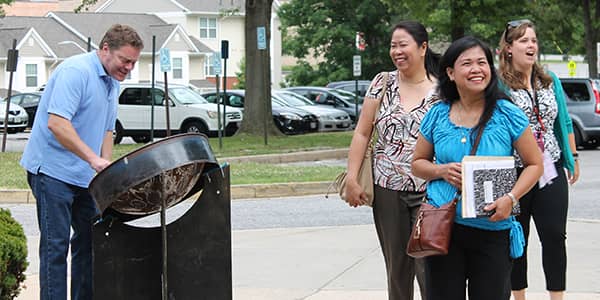Blog
Meet our new artists: Baltimore Improv Group

During the last two years, our roster has grown in size to encompass new artists, ensembles, and art forms. From slam poets to improvisers to Capoeira masters, these new artists are undeniably unique.
To introduce audiences to our new artists, we’ll be posting interviews with those who recently joined our roster, giving them a chance to share more about themselves and their experiences with Young Audiences so far.
The Baltimore Improv Group is a talented ensemble that came aboard our roster in 2013, and their performances and residencies never fail to evoke laughter and learning. Read on to find out why they became a Young Audiences roster artist, what they learned through our Teaching Artist Institute, and why they believe improv works so well in the classroom.
What is your background as an artist?
The Baltimore Improv Group is celebrating its 10th year as a theatre company in Baltimore. We started small but have grown close to 60 performers, and we perform 90+ shows a year, including our annual Baltimore Improv Festival. We also teach classes to adults, teens, and children. Our performers have studied and trained all across the country, and we continue to host the best improvisers in Baltimore.
How did you hear about Young Audiences?
Our Education Director, Bridget Cavaiola, worked with Young Audiences for years in her position as the Residential Life Director for the Upper Chesapeake Summer Center for the Arts. The center would bring in Young Audiences artists to perform for its campers. She knew it would be a perfect fit for BIG and made the suggestion that we audition.
What made you decide to become a Young Audiences roster artist?
Improv is such a natural fit with children. It encourages risk taking, creativity, and collaboration. We have hosted our own kids’ shows and classes but knew this would be a perfect match for us.
Have you had any programs through Young Audiences yet? What was the most memorable part?
YES! We had more than 10 assemblies at schools this year and our first residency, too! We are looking forward to more in the coming school year. Some of our favorite memories are watching the students come up on stage and perform in front of their peers and receive that amazing confidence boost that comes from taking a risk within a supportive environment! We certainly have traveled Maryland quite extensively, and we will certainly remember the fun trek to Flintstone Elementary School in Allegany County!

You recently completed the Teaching Artist Institute Seminar this spring. What was your favorite part of the program? How has that experience changed your approach to a program or your teaching practices?
The Teaching Artist Institute is an amazing opportunity where artists, educators, and staff truly collaborate to help process, define, and designate the importance of art in the classroom. We loved the guided lessons, hands-on experience, and being around such amazing, talented individuals. We felt that this experience helped to shine a new light on our own experiences as a teaching artist.
What does your art form in particular teach students?
Improv teaches a lot! Listening skills, taking risks, collaboration, the power of “yes,” learning from failure and mistakes, and much more!
Why do you believe it is important for every student to have access to the arts?
Art is the glue that solidifies education for so many kids. It allows them to access their own creativity and instills a level of respect and ownership over a child’s education.
Learn more about the Baltimore Improv Group’s offerings through Young Audiences here.
Keep an eye out for more interviews featuring our newest roster artists!
It takes a village

On a Monday afternoon in late June, students filled the Goodnow Community Center for the Summer Showcase, a vibrant display of visual and performing arts. The art shown was created by students, families, and community members through programs with Young Audiences teaching artists. Young Audiences has partnered with Goodnow since 2008 to bring a combination of arts assembly and residency programs to students attending the spring afterschool and summer programs at the center, which are made possible through generous funding from the Macht Fund of THE ASSOCIATED.
“We’re very fortunate that we have been able to have Young Audiences work with the Goodnow Community Center for the past six years,” said Gloria Jenkins, director of the center. “Our children have grown through their help.”
Those who stopped by the Summer Showcase got a taste of Young Audiences’ programs immediately when walking through the door, as students’ photographs taken with artist Christina Delgado were displayed by the entrance. These stunning images varied from full portraits to up-close snapshots.
First to perform at the showcase was Young Audiences roster ensemble Illstyle and Peace Productions, a dance company whose work focuses on the movement and spirit of Hip Hop. In her introduction for the group, Gloria noted, “When we’re planning events, the students always remind me to ‘get those boys that dance.’”
See more photos from the showcase here!
Illstyle and Peace Productions’ performance, titled NO Bullying, STOP Bullying: Let’s Be Friends, incorporated contemporary and old school dance moves with the positive message of acceptance. Throughout the show, cheers could be heard from all corners of the packed room. The program’s message was clear: when asked why they shouldn’t bully others, students passionately replied that they should treat others the way they want to be treated.
Acting as a backdrop for Illstyle and Peace Productions’ performance was a mural students created with the help of Young Audiences visual artist Danyett Tucker. “We came together and thought of a positive message we wanted to share with the community,” Danyett explained. The students decided on a quote from Harriet Tubman about following your dreams:
Every great dream begins with a dreamer. Always remember, you have within you the strength, the patience, and the passion to reach for the stars to change the world.

“We’re hoping that it will be used in performances for years to come,” said Danyett of the final product.
Coming together as a village and a community was the theme of the afternoon. It was especially prevalent during the unveiling of the “Mural Without Borders” artwork adorning the Goodnow Community Center’s facade. A sixth-month-long project, the work was created by members of the community with ceramic artist Herb Massie. It depicts the community’s past and present.
“The mural involved different aspects of the community to help put it together,” Rev. Kevin Bacon, Baltimore City Fire Dept. Chaplain said. “Police officers, the church, and schools all got involved.”
Retired Baltimore City Police Officer Craig Singleterry added, “People always say it takes a village. Well, this is our village.”
Though the project brought together all members of the community, it seemed to especially impact students. Rita Crews, a teacher at Hazelwood Elementary who helped students with the mural, shared, “The students were always eager to come in, even on Saturdays. They were the ones reminding me that we had to get to work.”
Barbara Combs, artist and art educator, believes that this interest in art has a practical application, noting that there “isn’t any career that art doesn’t touch.”
For Officer Singleterry, it’s also about showing students that they can do more. “Programs like these give students a new outlook on what they can do, from poetry to dance to music,” he said. “Young Audiences has brought more into their view.”
Summer learning comes to a close

See photos from the Young Audiences arts-integrated summer learning site!
The summer can be a time for fun in the sun with family and friends, but for many students across the country, it is a time of uncertainty. Without school, many at-risk students are left without adequate supervision, access to regular, healthy meals, and opportunities to participate in engaging and constructive activities. On average, all children can lose approximately two months of learning from the previous school year during the summer months without engaging education activities, and for low-income students, the loss is even greater. More than half of the achievement gap between low-income students and their more affluent peers can be attributed to the unequal access to summer learning opportunities.
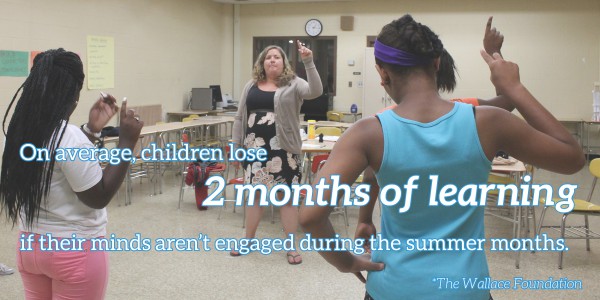
For five weeks this summer, Young Audiences again partnered with Baltimore City Public Schools to combat summer learning loss through a free math- and science-focused summer camp opportunity for Baltimore City middle school students. Young Audiences artists provided arts enrichment activities at seven Baltimore City 22nd Century Pioneers Summer Camp sites. In addition, for the first time, Young Audiences managed an eighth completely arts-integrated camp site at Edmondson Westside High School.
At the Young Audiences camp, morning math and science classes were co-taught by Baltimore City teachers and Young Audiences artists, who explored STEM subjects through the arts. Students had a choice in the art form they focused on during afternoon enrichment classes, including dance, photography, illustration and mural painting, improvisational theatre, Hip Hop, steel drum, or VEX robotics. The camp also included field trips, giving students the chance to apply their knowledge outside of the classroom.
The program was a learning opportunity for participating teachers as well, some of whom were new to arts integration as a teaching practice. Co-teaching with Young Audiences artists gave teachers the opportunity to try out a different way to approach each lesson, growing their knowledge of the arts and the natural connections that exist between core subjects and the arts.

In a recent survey of 500 U.S. teachers, 66 percent said it takes at least three to four weeks to re-teach content from the previous school year to get their students up to speed at the start of each new school year. At Edmondson Westside, the arts made learning fun and students both stayed intellectually engaged so they would not fall behind in their classes this coming school year, and also discovered a new way of learning through the arts. Students had the opportunity to develop their knowledge in math and science in a hands-on way, learning how the length of sound waves relates to the pitch of each note on a steel drum, or how a photographer or illustrator uses mathematical ratios to compose a piece. Students learned about themselves as they tried new things; took risks during classroom activities; and showcased what they had learned for others.
Read more about the Young Audiences arts-integrated summer learning site and see photos from this summer here.
Leaping headfirst into arts integration
By Grace Galarpe, Baltimore City Public School teacher
When I got involved in the Young Audiences and Baltimore City Public Schools 22nd Century Pioneers Arts-Based Summer Camp, I wasn’t sure if I was in the right place at first. Even though I’ve seen arts integration in the news, this summer was my first time really working with it. It was my first time working with Young Audiences, too, so when they told me that this program was all about arts integration, I was curious to learn more.
As a high school teacher, I’ve had the opportunity to collaborate with other core subject teachers before, but a collaboration with an artist? This was my first time and the idea interested me. In the past, I’ve used the arts in my classroom in the sense that we would sometimes draw or dance or sing. If I did incorporate the arts, it was separate. These activities would be after instruction or after school. The program this summer, where arts integration happened within the instruction, used a completely different method.
I was paired with Valerie Branch, a dancer. Before Valerie and I started teaching, we did lesson planning. Looking back, we consider this the biggest factor in our success because the planning helped us gain a greater understanding of how we would integrate the arts into our lessons.
I was very fortunate because both of us took the program very seriously. We would do thorough planning and would really talk about what was going to happen the next day and the next. Everything that Valerie and I accomplished this summer was possible because we had time to plan together. I wasn’t just going into a classroom where I would do everything by myself; it was a partnership.
See more photos from the Young Audiences arts-integrated summer learning site!
Our lessons weren’t always perfect, but since the teacher and the artist planned together, we could always reflect and revise–not just one of us, but both of us. We helped and respected each other, and as the summer went by, we became very comfortable with one another. When Valerie and I would sit down together, she made me feel confident about where the arts would come in and how we would make it possible. She made me feel more comfortable with her art form, too, and because of this, I could easily explain the elements of dance to students.
This summer, I realized that a dance activity can be incorporated with a science activity using the same concepts and vocabulary. That was amazing to me. At first, I wondered, “How will my students benefit from this collaboration and integration of the arts?” I now feel that arts integration gives students the chance to learn at a different level because we are able to touch multiple intelligences. I believe that our students achieved a deeper understanding of the science concepts and vocabulary that we taught them due to the integration of the arts into our teaching. They were able to apply what they had learned, not only through science but through dance, too.
Sometimes during the science instruction, students would ask: “Why do we need to learn this?” I would respond that they needed to know the terms and concepts so that we could apply them to our next dance choreography, and then they would get excited. When Valerie would talk about the elements of dance at the same time as the science, the students would be able to perform a dance choreography based on something related to science, such as pollution. That was a really wonderful outcome.
I can now see that if arts integration is a regular part of a classroom, it helps increase academic achievement and positive intervention regarding behavioral problems. I could tell that the arts were a huge help in attendance in our classroom, too, and I was so happy that the students looked forward to our class every day.
The arts also helped create responsibility. For example, Valerie and I decided that we needed to do something that would make the students understand that they had an obligation in the classroom. As a part of our teaching, we did an activity we called “Human Mirror,” which incorporates dance movements that develop a sense of responsibility. It requires listening, following directions correctly, being observant, and an understanding of what it means to be a leader and a follower. This was a great success for our class. I could sense that the students also gained respect for both of us. They called both me and Valerie artists, which surprised me. I was like, “Oh wow, I’m an artist!”
[youtube http://youtu.be/7laf55H68VE]
If ever given the chance, I would tell teachers who haven’t used arts integration not to be afraid of co-teaching with an artist. If there were an opportunity for me to be involved in another arts integration program, I would gladly do it. I’ve realized that in programs like this, the artist and teacher can become more than just teachers. I believe that they can do more than just share concepts or explain the academic side of things: they can inspire students’ lives.
Read more about the Young Audiences 22nd Century Pioneers Arts-Based Summer Camp site and see photos here.
How do we make learning fun?

By Chanel Traboldt, Third Grade Teacher at Harford Heights Elementary and Young Audiences Public Programs Summer Intern
Two middle school girls sit in the back of the classroom. One of them is sneaking a look at her cell phone under her desk; the other is braiding her hair. They are in a morning class during the first week of the Young Audiences and Baltimore City Public Schools 22nd Century Pioneers Arts-Based Summer Camp, and neither girl is looking at the front of the room or listening as the teacher, Ms. Moss, begins a math lesson on integers.
For a school teacher, like me, this can be the scene of many early mornings. The question you ask yourself each time is: “How do I better engage my students in their learning?” This often can seem like an impossible task. We know that if you make learning fun, students will want to learn. As an educator, there is an urgency to fight the achievement gap and prepare your students with the skills needed to be college and career ready. But now the tricky part: how do we make learning fun?
Young Audiences again partnered with Baltimore City Public Schools to solve this dilemma in July. In addition to providing arts enrichment activities at seven summer learning sites in Baltimore City, Young Audiences and City Schools created the first-ever completely arts-integrated summer learning site at Edmondson Westside High School. All eight sites were a part of the 22nd Century Pioneers Summer Camp, which is a free program for Baltimore City Public School middle school students.
Back in the classroom at the Young Audiences arts-integrated camp site something surprising happens. Ms. Moss continues her math lesson by projecting photographs students took the previous day while working with Young Audiences photographer Christina Delgado. The two girls stop what they were doing and look up. Ms. Moss asks the group what elements of photography are being used in each image and how these elements relate to what they are learning about integers. The girls raise their hands to join the conversation.
See more photos from the Young Audiences arts-integrated summer learning site!
During my time at Young Audiences’ site, I saw that teachers and artists had found a solution to many teachers’ student engagement woes. Integrating the arts into daily lesson plans allowed students to create, explore, express, have fun, and most importantly, to learn.
At the Young Audiences camp, nearly 150 students explored math and science concepts through the arts in classes and arts enrichment activities led by Baltimore City teachers and Young Audiences artists during the five-week program. Students chose the art form they would focus on during afternoon enrichment sessions, with choices including dance, photography, illustration and mural painting, theatre, Hip Hop, steel drums, and VEX robotics.
In another class, I saw a group of chatty sixth-graders sitting in the corner go completely silent to listen to steel drum musician Kevin Martin play musical phrases the class had created using what they had learned about ratios.
An unenthused student turned frustration into joy while drawing blueprints for a cage to carry a wild boar across a lake of alligators in visual artist Danyett Tucker’s eighth-grade math class.
Students, who were at first more focused on their weekend, turned that energy into an intricate dance routine about pollution in dancer Valerie Branch’s class.
As a teacher witnessing these moments of transformation, I am amazed at how easy it is to engage students in learning. The key is to understand that learning and the arts are not separate entities. By combining the two elements and creating arts-integrated educational lessons, students are truly able to learn while having fun.
Read more about the Young Audiences 22nd Century Pioneers Arts-Based Summer Camp site and see photos here.
Taking summer learning beyond the classroom

During the past few weeks, nearly 150 middle school students have dived into math and science concepts through the arts at the Young Audiences and Baltimore City Public Schools 22nd Century Pioneers Arts-Based Summer Camp. Students have learned how ratios are used in photography and how the physics of sound affect each note played on a steel drum. Through these art forms, and many more, students have been engaged in learning this summer so that they are prepared to hit the ground running this school year.
While most of the learning goes on inside the school, students have also had the opportunity to take their knowledge beyond the classroom walls on field trips. These excursions allow students to continue their hands-on learning in a new atmosphere, applying the skills and knowledge they’ve acquired throughout the summer.
The first trip was a visit to the Baltimore Museum of Industry, where students learned the ins and outs of technology and put their own engineering skills to the test. In one activity, students worked together in small groups to create a track that would carry a wooden ball and drop it into a can. This required them to go through the five steps of solving an engineering problem: plan, get materials, build, test, fix, and re-rest. Students were forced to adjust and readjust their designs before finally reaching their goal, usually resulting in loud cheers.
Students received another challenge: creating an artistic interpretation of the word industry. Groups joined together, combining their knowledge and creativity to come up with dances, skits, and songs that showed what they had learned that day.
See more photos from summer learning!
The following week, students traveled to Baltimore’s Artscape, America’s largest free arts festival organized by the Baltimore Office of Promotion and the Arts. Surrounded by artists of all disciplines, the students put on a show of their own at the Station North Stage, showcasing what they’ve been working on during their arts enrichment classes. The show opened with a lively Hip Hop dance performance from Jamaal Collier and Alicia Shaw’s Hip Hop class. After the performance, one student explained the four pillars of Hip Hop, the most important one being knowledge. Next, Valerie Branch and Heather Tuttle’s dance class got the crowd cheering with a dance set to Ariana Grande and Iggy Azelea’s “Problem.” Kevin Martin and Kevin Older’s students also got to show off their steel drum skills.
Even those who didn’t perform on stage took part in their own form of art-making. Throughout the day, Christina Delgado’s photography students captured Artscape from behind the lens, while Danyett Tucker’s illustration students filled up their sketchbooks with drawings of everything from festival attendees to graffiti on buildings.
Bridget Cavaiola’s improv class performed an exercise called “Improv Everywhere.” All over the festival, they held compliment battles, gave flowers to strangers, and posed as wax statues, making them the target of many curious stares and even a few pictures. See this group in action in the video below!
[youtube http://youtu.be/hg-sdwpGYQg]
Read more about the arts-integrated learning happening at the Young Audiences 22nd Century Pioneers Arts-Based Summer Camp site and see photos here.
Celebrating Failure: Lessons learned in a sixth-grade classroom
By Stacie Sanders Evans, Young Audiences/Arts for Learning Executive Director
Last week I visited the classroom of teaching artist and improv master Bridget Cavaiola and science teacher Heather Tuttle, who are teacher partners in our 22nd Century Pioneers Arts-Based Summer Camp in West Baltimore. Like in all of our classes, these two teachers were “starting with the art” by warming up brains and bodies with the drama game “Big Booty.” This particular game required kids to call on each other using a number instead of their name, and the goal of the game was to keep the it going as long as possible and as quickly as possible, without someone “messing up” by forgetting who had what number. (I realize this description doesn’t explain why this game is called Big Booty but just stick with me here…)
The first time a student messed up in Big Booty, everyone clapped. I wasn’t sure what was going on but smiles ensued and the game started over. Quickly another kid forgot which number they were and when their number was called, the game stalled. Once again everyone clapped and Bridget looked over at me to clue me in and said, “We celebrate our failures in here.” The game continued, and as the kids’ brains warmed up and the fear of making a mistake in front of their peers dissipated, the need to clap wasn’t as frequent. When they did clap, they laughed, they shrugged it off, and they quickly moved on.
When it came time to move on to the science lesson, the teachers wanted to recap the lesson from the day before about the engineer design process. Bridget realized she had mistakenly erased the board which had listed all the key terms shared yesterday and Heather realized she forgot her notebook for reference. Oops! I don’t think the situation could have been better orchestrated, in that moment Bridget and Heather, modeled “the way” by shrugging off their mistake and asked the class, “What can we do?”
See more photos from the Young Audiences arts-integrated summer learning site!
The kids immediately started calling out the key terms they learned the day before. “Imagine!” “Investigate!” “Test!” In a quick minute all the key terms were there. I noticed each term was delivered with a gesture. The day before, the students came up with a move that conveyed the essence of each word. This lesson recap evolved into sixth-grade boys and girls (remember those awkward years?) moving their arms, hands, and heads in space as they defined the engineer design process.
Bridget and Heather and their sixth-graders are onto something. The simple act of celebrating failure creates a safe space for trying something, even if you are unsure if you are right or if you might look silly. Just imagine what is possible when you remove that fear–real opportunities for exploration, experimentation, reflection, and growth emerge.
Read more about the arts-integrated learning happening at the Young Audiences 22nd Century Pioneers Arts-Based Summer Camp site and see more photos here.
Learning about other cultures through the steel drum

By Lindsay McLaughlin, Alternative Therapies Coordinator, The Pathways Schools
The Pathways Schools held its third annual Student Art Show on April 30. The event is a showcase for student creativity and artistic expression and is an opportunity to recognize standout partners, such as family members, Pathways staff and board members, businesses and agencies who employ or provide internships for our students, teaching artists who carry out residencies at our schools, and many others. This year’s Community Partner of the Year was Young Audiences teaching artist and musician Kevin Martin of Rockcreek Steel Drums for his dedication to bringing steel drum music and the vitality of Caribbean culture and history to our students.
During his residencies with students, Kevin teaches the basics of the steel drum, melody, rhythm, and so much more. Our students learned about another culture and saw a different way of seeing the world and themselves. Kevin has an ability to connect with students through music. That ability, along with his patience and consistent encouraging attitude, has made Kevin a sought-after teaching artist here at Pathways.
A couple years ago, our Pathways teachers and therapists were looking for ways to bring music into our schools so I asked Young Audiences staff to recommend a musician who could connect with our students. Thus Kevin came to us. He has completed no fewer than five residencies at Pathways in four of our six schools during the past two years. Next year, he is scheduled for a residency at a fifth school.
We are very grateful for Kevin, his commitment and talent, and also for organizations like Young Audiences that advocate for and make it possible for artists to come into our schools, work with our teachers and staff, and enhance the education and indeed the lives of our students and staff.
There’s a bigger picture here as well. As Pathways educators, we know that the best learning often doesn’t take place behind a desk. Our students thrive in a variety of learning environments, including museums and libraries, to job sites, such as ships sailing the Potomac tributaries and production studios at local television stations. Similarly, they learn best using a variety of means, like while playing a steel drum or molding a mosaic tile. This is because as human beings we need many avenues to take in the world and to release the prodigious power of our imaginations. This is what art does for us. It is an accessible way for us to connect our minds to the world that surrounds us. It gives us a way to communicate who we are–our ideas, thoughts, new understandings, and what we perceive
This is why it is critically important that we keep the arts vibrant in our schools for our students. How much better it is to experience the vitality of Caribbean culture through a steel drum compared to a textbook. How much better it is to feel the edges of a mosaic piece and use it to create an image with personal significance than look at a geometry chart or the dictionary entry for “symbol.” Art is how information becomes tangible and how knowledge becomes understanding. This is the sort of transformation that artists who come to work with our students facilitate every day. In turn, they are supported by dedicated arts educators and advocates who ensure that they are able to do what they do, particularly local and state arts councils and nonprofit organizations like Young Audiences.
Art–human expression in all its forms–should never be on the margins, whether we are talking about our communities or our schools. Thanks to the efforts of artists like Kevin and organizations like Young Audiences, it isn’t. Congratulations to the Pathways Community Partner of the Year Kevin Martin.
Learn more about Kevin and his program offering for schools.
Greetings from the staff of Summer Learning!
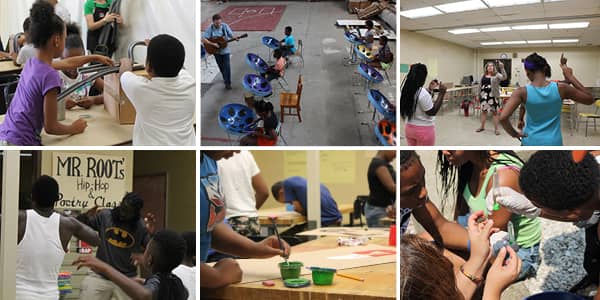
By Azya Maxton, 22nd Century Pioneers Arts-Based Summer Camp Arts Integration Facilitator
Summer Learning is off to a great start. Our sixth-graders are studying coordinate grids and the engineering process. Seventh- and eighth-graders are learning about run off in science and ratio in math. It’s so exciting to see them learning their math and science through arts integration and hands-on projects. Students have been designing roofs, buildings, and even cities! Last week, we got to explore the engineering process, and learn about science and industry during a field trip to the Baltimore Museum of Industry. Students were also given an opportunity to test water from the Chesapeake Bay for phosphates, dissolved oxygen, pH, and Chlorine. Today, students participating in arts enrichment classes will have the opportunity to present their work at Baltimore’s Artscape while students in robotics go on to a citywide competition!
We’ll continue to keep you posted on the wonderful learning of our middle school students throughout the next few weeks!
Read more about the arts-integrated learning happening at the Young Audiences 22nd Century Pioneers Arts-Based Summer Camp site and see photos here.
Students help raise funds to bring the arts to other schools
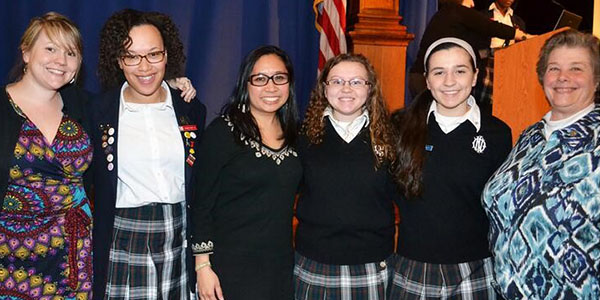
My name is Amanda Sessa and I am a student at the Institute of Notre Dame (IND) in Baltimore City. I am a member of the Shalom Club, a worldwide high school organization dedicated to peace. At IND, the Shalom Club partners with local charities to raise money for them.
For as long as I can remember my father, Thomas Sessa, has been on the board of Young Audiences/Arts for Learning. So, when the Shalom Club was looking to partner with a new organization, I automatically thought of Young Audiences. When I told the other members of Shalom Club about the work Young Audiences does to bring arts experiences to Maryland students, they jumped at the opportunity to partner with them because we believe that education is a gateway to peace in the world. Additionally, IND has focused on expanding its arts programs and its use of the arts to more fully develop the education of our students. Therefore Young Audiences was a perfect partner for IND and the Shalom Club.
On April 2, 2014, IND held a fundraiser called Bread and Soup Day organized by the Shalom Club. Prior to Bread and Soup Day, Young Audiences staff members Pat Cruz and Jess Porter (who is also an alumna of IND) came to our school to educate the students about Young Audiences and its mission. The response was overwhelming. On Bread and Soup Day we sold lunches to IND students and donated all of the proceeds (approximately $400) to Young Audiences.
I am very excited that I was able to connect IND with Young Audiences, especially because both organizations are dedicated to maximizing student achievement in Baltimore City and beyond. In addition to introducing Young Audiences to IND’s 400 students and its faculty, I learned a great deal about the role that Young Audiences plays in educating Maryland’s students, especially students of limited means.
I am lucky. I have always had an arts program in my school and assumed that all other students were also exposed to the arts. Pat and Jess showed me that many students–who often could most benefit from arts programs–do not have the chance to learn with the arts in school. I saw that my participation in middle school theatre performances and IND’s Choral Performance class should not be taken for granted. These experiences have been some of the greatest educational opportunities for me but are not available to thousands of students throughout Maryland.
My teachers have used the arts, including music and dance, in so many ways. I learned the alphabet through the ABC song, danced to a song warning me about talking to strangers, and continue to use music and song to recall words in Spanish. In English class this year my teacher had us act out the plays we read so we could see the events as the author intended. When we were not reading, she would have us draw pictures of settings, characters, and symbols to depict the text in a different way. The arts make learning fun and interesting and these were some of the best assignments I was given. It saddens me that they are not available to everyone.
The Shalom Club and the IND community hopes that our donation will help fund the important work of Young Audiences. We hope that our efforts will allow Young Audiences to reach students who otherwise would never experience the power of the arts educationally or in their lives outside of the classroom. I am proud to have been able to make a contribution to Young Audiences’ important work. I hope that IND and Young Audiences will continue to be partners for years to come.
Many thanks to Amanda Sessa and all the members of IND’s Shalom Club for their support of Young Audiences and increasing access to arts-in-education programs for all Maryland students!
Summer Learning begins

The school year may have ended, but for Young Audiences, that doesn’t mean the fun, arts-integrated learning stops. Young Audiences has again partnered with Baltimore City Public Schools to bring arts enrichment activities to seven Baltimore City 22nd Century Pioneers Arts-Based Summer Camp sites. In addition, for the first time Young Audiences is also managing an eighth completely arts-integrated camp site at Edmondson Westside High School. The 22nd Century Pioneers Summer Camp is free to Baltimore City Public Schools middle school students.
At the Young Audiences camp, nearly 150 students will explore math and science concepts through the arts in classes and arts enrichment activities led by Baltimore City teachers and Young Audiences artists during the five-week program. Students can select the art form they will focus on during enrichment sessions, with choices including dance, photography, illustration and mural painting, theatre, Hip Hop, steel drum, or VEX robotics.
Because this is the first-ever Young Audiences arts-based summer learning site, we thought it deserved an equally spectacular kick-off event. As students arrived, what better way to greet them than with the arts?
On Monday, June 30, as students walked up to the school for the opening day of camp, the first thing that hit their ears was the sound of a steel drum being played by Young Audiences roster artist Kevin Martin of Rockcreek Steel Drums. Kevin has been building and playing steel drums for more than 20 years; this summer, he will show students how the instrument connects to math.
See more photos from the Young Audiences arts-integrated summer learning site!
On the way into the building, students passed the dancing Valerie Branch, a new Young Audiences artist whose energetic moves caused many to stop and watch. Valerie will get students moving while studying science this summer. Those walking in also got to witness the Hip Hop talents of musician Jamaal “Mr. Root” Collier, who will use his skills to bring math to life. Bridget Cavaiola of Baltimore Improv Group used improvisational theatre techniques to direct students inside the building. With her help, students will learn how theatre can make abstract science concepts concrete.
The excitement wasn’t just at the front of the school. Once inside, students had the opportunity to take part in photographer Christina Delgado’s photo booth, dressing themselves in hats and glasses before striking poses. Students will have the chance to go behind the lens with Christina to learn the art of photography and its connections to math. Visual artist Danyett Tucker will link illustration to science. As students looked on, she created a colorful mural with images of various art forms incorporated into the design, from music notes to microphones to Polaroid pictures. Students were invited to create murals of their own, as each table was decked with markers and a giant sheet of paper.
All children, regardless of their resources or where they live, lose some math skills during the summer. Studies show that economically-disadvantaged students also lose literacy skills during this “summer learning slide.” Experts believe that the achievement gap between middle- and low-income students not only grows during the summer—it exists largely because of the summer.
Programs like 22nd Century Pioneers provide students with a safe place to go during the day, access to free healthy meals, adequate adult supervision, and positive, educational activities. This summer Young Audiences artists will connect students with new experiences through the arts as they learn about math and science in a new way and build their self-confidence as they gain knowledge and skills.
Check back in with the Young Audiences blog throughout July as we look at how these artist and teacher pairs are using arts integration in their classrooms.
Happy summer and happy learning!
New National Core Arts Standards launched

Last month, the National Coalition for Core Arts Standards introduced the new National Core Arts Standards. Developed through the collaboration of arts organizations, teaching artists, teachers, and practitioners, these standards aim to uphold the quality of teaching and learning.
Originally published in 1994, the National Core Arts Standards were the nation’s first guidelines for arts education. Since then, they have led arts education through growth in design, delivery, and assessment. Recent surveys, however, had shown that priorities of education policy as well as instructional resources and practices of arts educators have significantly changed since the standards’ initial publication, leading to a need for revision.
Thousands of artists, teachers, and arts educators, as well as three reviews from the public, helped to create the new National Core Arts Standards. We are proud to note that the Young Audiences Arts for Learning National Office played a significant role in writing the standards. Young Audiences also managed the creation of the new standards’ website.
After two years of development, the new standards and website were officially launched on June 4. While the newly implemented standards were closely built off of those published 20 years ago, they also show significant growth. The revision includes an emphasis on communication and collaboration, two 21st Century Skills now stressed by higher education and employers.
The new Core Arts Standards also supplement the original four artistic disciplines of dance, music, theatre, and visual arts with a fifth: media arts. This encompasses such mediums as film, animation, and gaming or interactive- and computer-based art making. The new standards also support the development of artistic literacy by encouraging students to independently take part in four artistic processes: creating, performing/producing/presenting, responding, and connecting. These processes can be seen in the 11 Anchor Standards that are common across all five art forms.
Questions about the new standards? Visit Young Audiences’ National Core Arts Standards FAQ.










